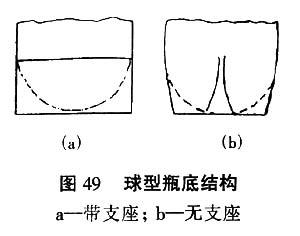4. Bottle design
Basic bottle type: Ball type under a certain volume condition, the smallest surface area, the most use of materials, and easy molding, even force. From crack resistance is an optimal structural design. However, it requires a long neck that can pour the contents and a base that allows the bottle to stand upright, so the ball bottle and the ball bottom are less practical. As shown in Figure 49a. Based on the design of the bottom of the ball base, adding some petal or sawtooth structure can not only achieve the effect of the bottom of the ball type, but also can make the bottle stand upright without any additional. As shown in Figure 49b; cylindrical type is a common bottle type, low cost, full-featured. Good contact with the printing cylinder during rotation, easy printing, and stability in a large ratio of length to diameter, facilitating filling, transport, crating and stacking; both round and double curved bottles Aesthetic, but also easy to hold, but the molding is slightly more difficult, poor economical; egg round bottle appearance size is good, but its production is more difficult than the round bottle; prism bottles in the negative turn need to have a rounded transition, in three There is also a spherical transition at the interface, the radius of which varies depending on the purpose; the surface structure of the bottle wall changes more and can be linear, tapering or convex, or can be waisted. The bottle surface can be smooth or ribbed.
Basic bottle type: Ball type under a certain volume condition, the smallest surface area, the most use of materials, and easy molding, even force. From crack resistance is an optimal structural design. However, it requires a long neck that can pour the contents and a base that allows the bottle to stand upright, so the ball bottle and the ball bottom are less practical. As shown in Figure 49a. Based on the design of the bottom of the ball base, adding some petal or sawtooth structure can not only achieve the effect of the bottom of the ball type, but also can make the bottle stand upright without any additional. As shown in Figure 49b; cylindrical type is a common bottle type, low cost, full-featured. Good contact with the printing cylinder during rotation, easy printing, and stability in a large ratio of length to diameter, facilitating filling, transport, crating and stacking; both round and double curved bottles Aesthetic, but also easy to hold, but the molding is slightly more difficult, poor economical; egg round bottle appearance size is good, but its production is more difficult than the round bottle; prism bottles in the negative turn need to have a rounded transition, in three There is also a spherical transition at the interface, the radius of which varies depending on the purpose; the surface structure of the bottle wall changes more and can be linear, tapering or convex, or can be waisted. The bottle surface can be smooth or ribbed.

The requirements of the automatic filling line for the bottle type: First, the bottom of the plastic bottle must have a concave surface, which can reduce the supporting surface at the bottom of the container and can be easily and smoothly placed. As shown in Figure 50; Second, the container side wall near the bottom of the bottle and the shoulders are each a straight part, to provide a control area for the operation of the storage bottle turntable; Third, rectangular and square bottles must have rounded corners Not to be stuck on the guide rail and the star wheel, but also easy to insert the mechanical hand between the two bottles; Fourth, as far as possible the use of straight side containers, less use of the cone side of the container; Fifth, the use of cylindrical and rectangular Bottles, less egg round and shaped bottles. As shown in Figure 51.


(Text / Zhao Yanwei)